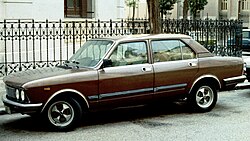This article needs additional citations for verification .(November 2018) |
| SEAT 132 | |
|---|---|
 | |
| Overview | |
| Manufacturer | SEAT |
| Production | 1973–1982 |
| Assembly | Spain: Barcelona (Zona Franca) |
| Body and chassis | |
| Class | Large family car (D) |
| Body style | 4-door sedan |
| Layout | FR layout |
| Related | Fiat 132 |
| Powertrain | |
| Engine | 1.6–1.9L I4 (Gasoline) 2.0–2.2L I4 (Diesel) |
| Dimensions | |
| Wheelbase | 2,557 mm (100.7 in) |
| Length | 4,392 mm (172.9 in) |
| Width | 1,640 mm (65 in) |
| Height | 1,435 mm (56.5 in) |
| Chronology | |
| Predecessor | SEAT 1500 |
| Successor | SEAT Exeo |
The SEAT 132 is a four door, rear wheel drive notchback saloon produced by SEAT from 1973 to 1982, as a rebadged version of the Fiat 132. It was presented for the first time at the Barcelona Motor Show, and was assembled in Barcelona's Zona Franca in Catalonia, Spain.
For the important taxi market, the 132 filled the niche, vacated with the withdrawal in 1970, of the diesel engined SEAT 1500, the 132 being usefully larger than the SEAT 124, which was SEAT's largest model during the beginning of the 1970s.

SEAT's new car shared its body with the Fiat 132, but when launched in May 1973 it featured its own engine options:
- The SEAT 132 1600 had a four cylinder 1592 cc engine of 98 bhp (73 kW; 99 PS) .
- The SEAT 132 1800 had a four cylinder 1756 cc engine of 107 bhp (80 kW; 108 PS) .
- The SEAT 132 Diesel featured a two litre 55 bhp (41 kW; 56 PS) Mercedes Benz engine, corresponding to that offered in the Mercedes Benz 200D. This followed the pattern established with the SEAT 1500, which had also been available with a diesel engine from Mercedes Benz.
In 1976, an automatic transmission option was offered, which may have been a response to the success in Spain of the locally assembled, and similarly enhanced Chrysler Two Litre. [1] From 1979, the SEAT 132 2000 became available, with one four cylinder 1920 cc engine of 109 bhp (81 kW; 111 PS): in due course, one larger 2.2 litre, four cylinder Mercedes diesel version was also offered.
In the beginning of the 1980s, extensive discussions concerning funding and control took place between the major share holder, the Government of Spain, and Fiat: SEAT needed major capital investment, which Fiat was not prepared to inject. The outcome, by 1982, was an end after nearly thirty years, to the relationship with Fiat.
Already in 1981, Fiat having by now switched to their new model, the Argenta, production of the SEAT 132 ceased, after approximately 100,000 examples had been produced. No direct replacement in this class was, up until 2009, offered by the company. The SEAT Exeo could be seen as the belated replacement, however.
| SEAT 132 | 1600 | 1800 | 1900 | Diesel 2000 | Diesel 2200 |
|---|---|---|---|---|---|
| Engine: | Four cylinder inline engine (four stroke), front mounted | ||||
| Displacement: | 1592 cc | 1756 cc | 1920 cc | 1988 cc | 2197 cc |
| Bore x Stroke: | 80 x 79.2 mm | 84 x 79.2 mm | 84 x 86.6 mm | 87 x 83.6 mm | 87 x 92.4 mm |
| Max. Power @ rpm: | 98 hp (73 kW) @ 6000 | 107 hp (80 kW) @ 6000 | 109 hp (81 kW) @ 5800 | 55 hp (41 kW) @ 4200 | 60 hp (45 kW) @ 4200 |
| Max. Torque @ rpm: | 129 N⋅m (95 lb⋅ft) @ 3400 | 141 N⋅m (104 lb⋅ft) @ 4000 | 151 N⋅m (111 lb⋅ft) @ 3000 | 113 N⋅m (83 lb⋅ft) @ 2400 | 126 N⋅m (93 lb⋅ft) @ 2400 |
| Compression Ratio: | 9.0:1 | 8.9:1 | 8.9:1 | 21.0:1 | |
| Fuel system: | 1 Weber or Solex downdraft carb. (2bbl) | Diesel injection | |||
| Valvetrain: | DOHC, tooth belt | OHC, chain | |||
| Cooling: | Water | ||||
| Gearbox: | Four speed manual | Four speed manual Five speed manual optional GM Three speed automatic optional rear wheel drive | Four speed manual | ||
| Front suspension: | Upper double wishbones, lower wishbones, coil springs, stabilizing bar | ||||
| Rear suspension:: | Live axle, upper wishbones, lower trailing arms, coil springs | ||||
| Brakes: | Front and rear disc brakes (Ø 227 mm) | ||||
| Steering: | Recirculating ball steering, power-assisted | ||||
| Body: | Steel, unibody construction | ||||
| Track front/rear: | 1,320 mm (52 in) / 1,325 mm (52.2 in) | ||||
| Wheelbase: | 2,555 mm (100.6 in) | ||||
| Length x Width x Height: | 4,380 mm (172 in) x 1,640 mm (65 in) x 1,430 mm (56 in) mm | ||||
| Weight: | 1,070 kg (2,360 lb) | 1,095 kg (2,414 lb) | 1,140 kg (2,510 lb) | 1,100 kg (2,400 lb) | 1,215 kg (2,679 lb) |
| Top speed: | 165 km/h (103 mph) | 170 km/h (110 mph) | 170 km/h (110 mph) | 130 km/h (81 mph) | 140 km/h (87 mph) |
| 0–100 km/h (0−62 mph): | 12.5 s | 11.2 s | 11.2 s | n.a. | |
| Fuel consumption (estimates): | 10.0 litres per 100 kilometres (28 mpg‑imp; 24 mpg‑US)−15.0 litres per 100 kilometres (18.8 mpg‑imp; 15.7 mpg‑US) | 7.0 litres per 100 kilometres (40 mpg‑imp; 34 mpg‑US)−9.5 litres per 100 kilometres (30 mpg‑imp; 25 mpg‑US) | |||